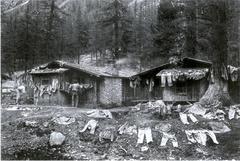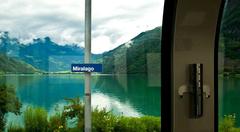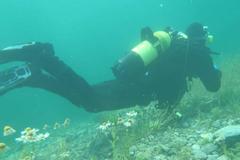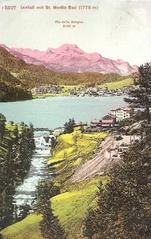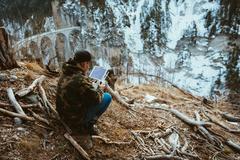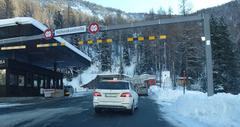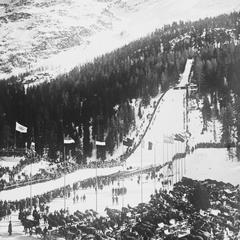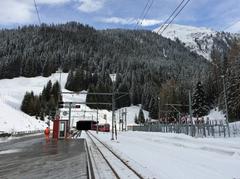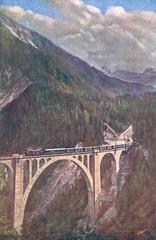
Disentis Abbey: Comprehensive Visiting Guide, History, and Tips for Exploring Grisons’ Historic Treasure
Date: 14/06/2025
Introduction: The Enduring Legacy of Disentis Abbey
Set amidst the stunning upper Surselva Valley in the Canton of Grisons, Switzerland, Disentis Abbey (Benediktiner Kloster Disentis, Romansh: Mustér) is one of the nation’s oldest and most important Benedictine monasteries. Established in the early 8th century, the abbey’s legacy stretches across thirteen centuries as a spiritual, cultural, and political beacon in the Alps. Renowned for its legendary origins involving Saints Placidus and Sigisbert, and its reconstruction under Charles Martel and Saint Pirmin, the abbey has played a vital role in regional history and the preservation of the Romansh language and culture.
Visitors to Disentis Abbey are greeted by a striking blend of medieval fortifications and Baroque opulence, with intricately decorated interiors, historical artifacts, and a dynamic monastic community. The abbey is equally a center for education, hosting a monastic school and maintaining deep ties to local traditions.
This guide presents everything you need to plan a memorable visit, from practical information on hours and ticketing to insights into the abbey’s historical, architectural, and cultural significance. For the most current details, consult trusted sources such as MySwitzerland, SpottingHistory, and the official Disentis Abbey website.
Table of Contents
- Discover Disentis Abbey: Why Visit?
- Historical Overview: Foundations and Evolution
- Architectural and Artistic Highlights
- Cultural Engagement and Social Impact
- Practical Visitor Information
- Nearby Attractions and Activities
- Frequently Asked Questions (FAQ)
- Visitor Tips and Media
- Contact and Further Information
- Conclusion: Experience Disentis Abbey
- Sources and Official Links
Discover Disentis Abbey: Why Visit?
Disentis Abbey is a cornerstone of Swiss history and culture. Its commanding location near the Lukmanier and Oberalp passes made it a crossroads for imperial travelers and pilgrims. Today, it offers a unique window into centuries of spiritual life, education, and regional artistry. The abbey’s museum, church, and grounds provide immersive experiences for history enthusiasts, architecture lovers, and anyone interested in the living heritage of the Alps (myswitzerland.com).
Historical Overview: Foundations and Evolution
Early Beginnings and Legendary Origins
Traditional accounts tie the founding of Disentis Abbey to 614 CE, with Saints Placidus and Sigisbert as its earliest figures. After destruction by the Avars in 670, the abbey was reportedly rebuilt by Charles Martel and Saint Pirmin around 711. However, archaeological evidence situates its true foundation between 700–720 CE. The dedication to Saint Martin of Tours reflects the region’s early Christian heritage (SpottingHistory).
Growth as a Spiritual and Political Center
Disentis Abbey’s strategic position made it a prominent spiritual and political hub. During the Middle Ages, it hosted emperors and exerted significant secular power, with the prince-abbot ruling over the Rhine valley. The abbey helped found the Grey League in 1395, a critical step toward Swiss Confederation (Andermatt-Sedrun-Disentis).
Architectural and Artistic Highlights
Medieval Roots and Baroque Splendor
The original Carolingian structures were characterized by sturdy stonework and Romanesque elements—rounded arches and thick walls—that remain in foundational areas and crypts (newlyswissed.com). After numerous devastations, the abbey was rebuilt in Baroque style (1683–1704), featuring twin towers, a grand façade, and richly adorned interiors with frescoes and gilded altars (bonjouralps.com).
Artistic Treasures
The church’s ceiling frescoes, masterfully painted by Johann Baptist Zimmermann and others, depict scenes from the lives of St. Benedict and the Virgin Mary. The choir stalls, high altar, and historic organ showcase local craftsmanship and the abbey’s musical tradition. The museum houses sacred art, textiles, manuscripts, and natural history collections from the Upper Rhine Valley (myswitzerland.com).
Modern Additions
Educational buildings such as the Gymnasium Kloster Disentis and the boarding house for young women, designed by Gion A. Caminada, integrate modern architectural elements while honoring monastic traditions (newlyswissed.com).
Cultural Engagement and Social Impact
Language and Regional Identity
Disentis Abbey is a bastion of Romansh language and culture, particularly the Sursilvan dialect. Religious and educational activities are often conducted in Romansh, reinforcing local identity (Andermatt-Sedrun-Disentis).
Educational and Social Roles
The abbey’s school—documented since the 13th century—draws students from across Switzerland and abroad, promoting intercultural exchange. The abbey supports the local economy through education, agriculture, and hospitality (SpottingHistory).
Festivals, Events, and Community Life
Disentis Abbey hosts religious services, concerts, and cultural events, contributing to a vibrant community atmosphere. Traditions like the feast of Saint Martin are central to the abbey’s role in preserving local customs (Andermatt-Sedrun-Disentis).
Practical Visitor Information
Opening Hours and Tickets
- Abbey Church: Daily, 9:00 AM – 5:00 PM (may vary seasonally)
- Museum: Similar hours; check official website for updates
- Tickets: Church entry is free; museum admission approx. CHF 8 (adults), CHF 5 (seniors/students), children under 16 free
Guided Tours
- Available in multiple languages; advance booking recommended, especially for groups or during peak seasons
Accessibility
- The abbey is wheelchair accessible, with adapted facilities and ramps. Assistance available upon request.
Getting There
- By Train: Disentis/Mustér station (Rhaetian Railway) is a short walk to the abbey (Powderhounds)
- By Car: Parking available at Klosterhof, with clear signage from the village center
Facilities
- Dining: On-site restaurant serves Surselva specialties; bakery offers traditional breads and pastries (montagnaestate.it)
- Shop: Sells religious items, books, local crafts, and produce from the abbey’s farm
- Restrooms and accessibility features are present throughout the complex
COVID-19 Guidelines
- Book in advance for guided tours. Masks may be required indoors; hand sanitizing stations provided.
Nearby Attractions and Activities
- Sankta Agatha Chapel and Saint Placidius Church (swissactivities.com)
- Cristallina Mineral Museum
- Russeiner Bridge (photography spot)
- Outdoor Activities: Hiking, mountain biking, gold panning, and exploring Alpine landscapes
The village of Disentis offers authentic Romansh culture, traditional cuisine, and access to scenic mountain trails and the source of the Rhine.
Frequently Asked Questions (FAQ)
Q: What are the visiting hours of Disentis Abbey?
A: Generally, 9:00 AM – 5:00 PM daily; check the official website for seasonal updates.
Q: Is there an entrance fee?
A: Church entry is free; museum admission ranges from CHF 5–8.
Q: Are guided tours available?
A: Yes, in various languages; book in advance.
Q: Is the abbey accessible for visitors with disabilities?
A: Yes, with ramps and adapted facilities.
Q: How do I get there by public transport?
A: Via Disentis/Mustér train station, a short walk away.
Q: Are there special events or religious services for visitors?
A: Yes, including concerts, lectures, festivals, and daily prayer services.
Visitor Tips and Media
- Dress Code: Modest attire recommended for church areas.
- Photography: Allowed except during services and in private monastic areas.
- Languages: Romansh and German are predominant; English and Italian are understood.
- Souvenirs: Abbey shop offers unique local products.
For visual planning, consult high-quality images with SEO-optimized alt tags such as “Disentis Abbey Baroque Facade,” “Disentis Abbey Frescoes,” and “Disentis Abbey Museum Exhibits.” Maps and virtual tours may be available on the official website.
Contact and Further Information
-
Disentis Abbey (Benediktiner Kloster Disentis)
Via Claustra 1, 7180 Disentis/Mustér, Switzerland
Phone: +41 (0)81 929 69 00
Email: [email protected]
Official Website -
Sedrun Disentis Tourismus
Via Alpsu 64a, 7188 Sedrun
Phone: +41 (0)81 920 40 30
Email: [email protected]
Tourism Website
Conclusion: Experience Disentis Abbey
Disentis Abbey stands as a living testament to Switzerland’s spiritual, cultural, and historical heritage. With its magnificent Baroque architecture, enduring monastic traditions, and active role in regional life, the abbey invites visitors to journey through centuries of faith, artistry, and community. Whether you seek inspiration, education, or simply the peace of the Alps, Disentis Abbey offers an enriching and unforgettable experience.
For up-to-date information, guided audio tours, and local tips, download the Audiala app and follow the abbey’s social media channels.
Sources and Official Links
- Disentis Abbey: Visitor Guide (bonjouralps.com)
- Disentis Abbey Official Site (kloster-disentis.ch)
- Disentis Abbey: Architectural Heritage (newlyswissed.com)
- Disentis Abbey Historical Overview (SpottingHistory)
- Disentis Monastery Travel Guide (myswitzerland.com)
- Sedrun Disentis Tourism (disentis-sedrun.ch)
- Disentis Arrival and Activities (swissactivities.com)
- Disentis Arrival and Parking (graubuenden.ch)
- Disentis Activities Overview (montagnaestate.it)
- Disentis Winter Guide (Powderhounds)
- Romansh Culture and Community (Andermatt-Sedrun-Disentis)









